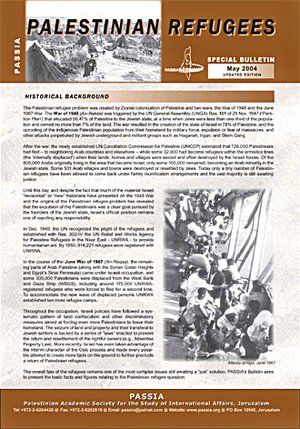Palestinian Refugees - Special Bulletin
This Special Bulletin presents the basic facts and figures relating to the Palestinian refugee question. It examines the historical origin of the refugee problem and the refugees' status in international law. The situation of the refugees today, including their numbers. their distribution worldwide, and their living conditions in the different Arab host countries an d elsewhere is outlined. Further described is the role of the refugee question in the peace process and the final status negotiations, as well as the positions of the parties involved. The text is illustrated with photographs, maps, graphs and tables, and also includes a list of further research sources.
Overview
The Palestinian refugee problem was created by Zionist colonization of Palestine and two wars, the War of 1948 and the June 1967 War. The War of 1948 (An-Nakba) was triggered by the UN General Assembly (UNGA) Res. 181 of 29 Nov. 1947 (‘Partition Plan’) that allocated 56.47% of Palestine to the Jewish state, at a time when Jews were less than one-third of the population and owned no more than 7% of the land. The war resulted in the creation of the state of Israel in 78% of Palestine, and the uprooting of the indigenous Palestinian population from their homeland by military force, expulsion or fear of massacres, and other attacks perpetrated by Jewish underground and militant groups such as Haganah, Irgun, and Stern Gang. After the war, the newly established UN Conciliation Commission for Palestine (UNCCP) estimated that 726,000 Palestinians had fled – to neighboring Arab countries and elsewhere – while some 32,000 had become refugees within the armistice lines (the ‘internally displaced’) when their lands, homes and villages were seized and often destroyed by the Israeli forces. Of the 800,000 Arabs originally living in the area that became Israel, only some 100,000 remained, becoming an Arab minority in the Jewish state. Some 531 Arab villages and towns were destroyed or resettled by Jews. Today only a tiny number of Palestinian refugees have been allowed to come back under family reunification arrangements and the vast majority is still awaiting justice.
Until this day, and despite the fact that much of the material Israeli “revisionist” or “new” historians have presented on the 1948 War and the origins of the Palestinian refugee problem has revealed that the expulsion of the Palestinians was a clear goal pursued by the founders of the Jewish state, Israel’s official position remains one of rejecting any responsibility. In Dec. 1949, the UN recognized the plight of the refugees and established with Res. 302-IV the UN Relief and Works Agency for Palestine Refugees in the Near East - UNRWA - to provide humanitarian aid. By 1950, 914,221 refugees were registered with UNRWA. In the course of the June War of 1967 (An-Naqsa), the remaining parts of Arab Palestine (along with the Syrian Golan Heights and Egypt’s Sinai Peninsula) came under Israeli occupation, and some 300,000 Palestinians were displaced from the West Bank and Gaza Strip (WBGS), including around 175,000 UNRWA registered refugees who were forced to flee for a second time. To accommodate the new wave of displaced persons UNRWA established ten more refugee camps.Throughout the occupation, Israeli policies have followed a systematic pattern of land confiscation and other discriminatory measures aimed at forcing even more Palestinians to leave their homeland. The seizure of land and property and their transferal to Jewish settlers is backed by a series of “laws” enacted to prevent the return and resettlement of the rightful owners (e.g., Absentee Property Law). More recently, Israel has even taken advantage of the interim character of the Oslo process and made every possible attempt to create more facts on the ground to further preclude a return of Palestinian refugees. The overall fate of the refugees remains one of the most complex issues still awaiting a “just” solution. PASSIA’s Bulletin aims to present the basic facts and figures relating to the Palestinian refugee question.

